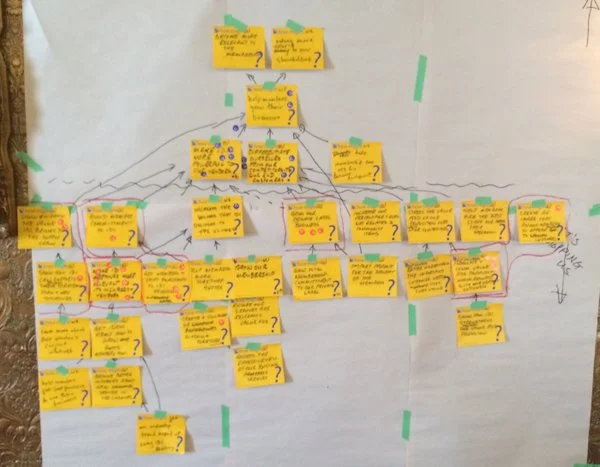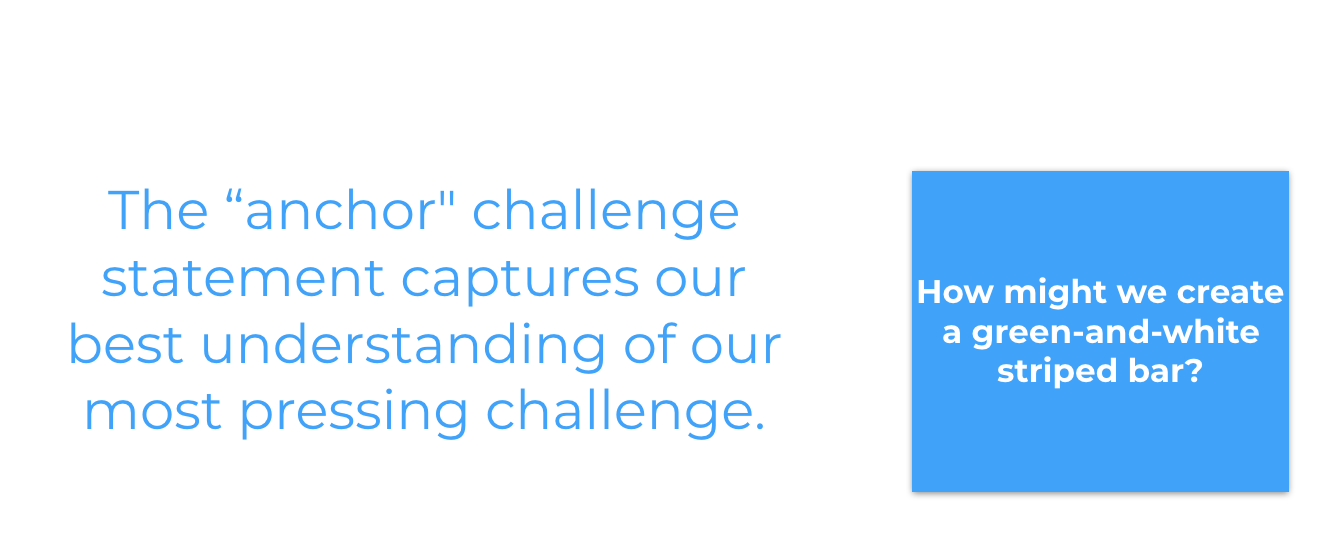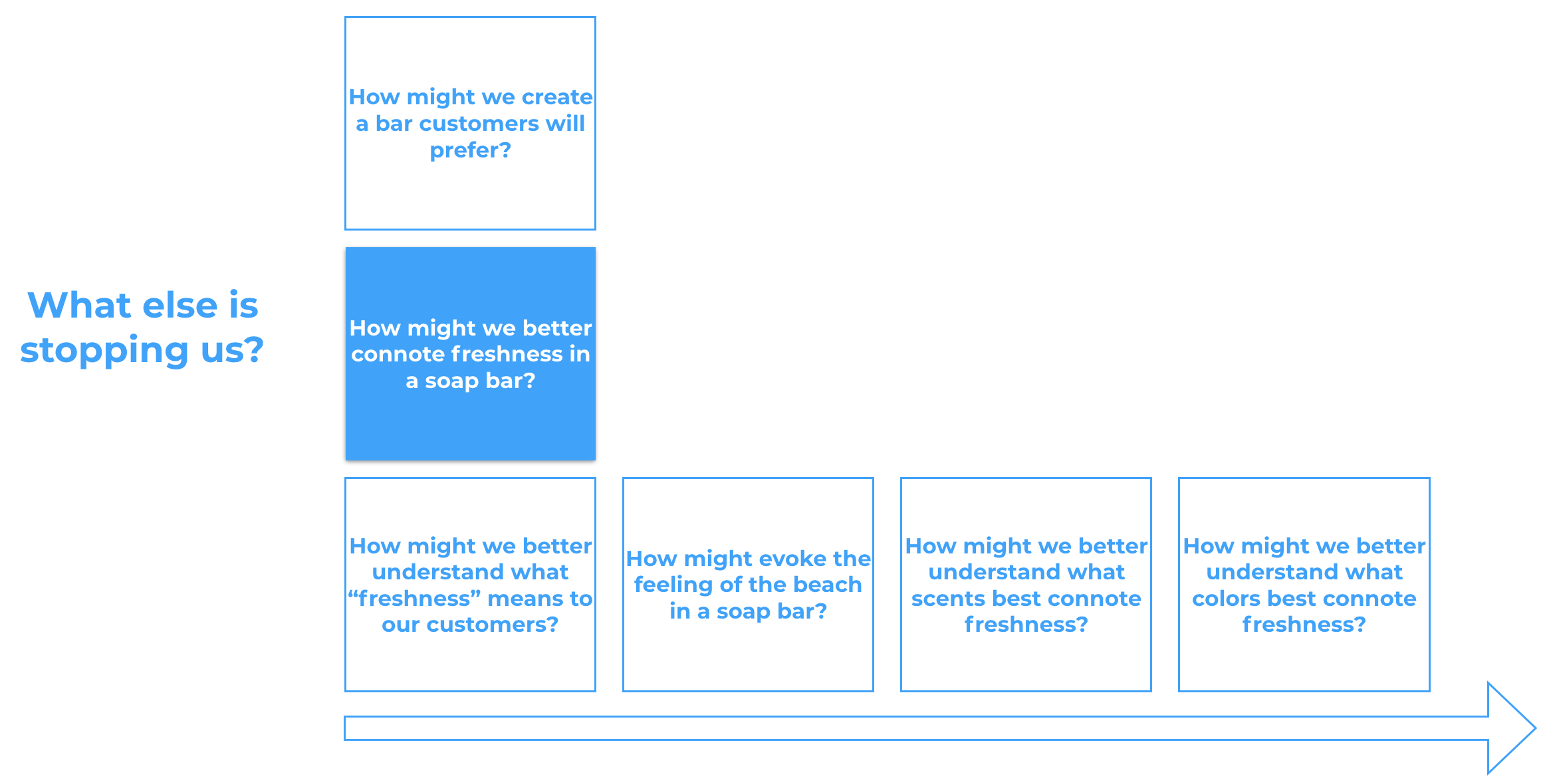Challenge mapping*, documented by veteran innovator Min Basadur in his 2016 book Design-Centered Entrepreneurship, is a powerful, systematic method to quickly articulate the set of interrelated challenges a digital product team faces at any given point in time.
There are a few enormous benefits to using challenge maps. First, challenge maps help teams surface the key decision points that will have the greatest potential impact, both for users and the business. Challenge maps also help teams get aligned and on the same page about the most impactful next step. Finally, and maybe most importantly, challenge maps help teams see where their thinking has been too limited, inspire fresh thinking, and unlock innovation.
In Part One of this series, Challenge Map Basics, we explore:
Challenge statements, which are the building blocks of challenge maps
How, exactly, to build a challenge map, step by step
In Part Two, Challenge Maps in Practice, we share:
A few examples of where Challenge Maps can be particularly powerful in the design process
A template so you can get started making your own challenge maps!
Challenge Map Basics
Key concept: The Challenge Statement
First, let’s talk about the basic building block of a challenge map: the challenge statement. A challenge statement simply translates a fact into a positively stated challenge that begins with “How might we?”
For example, let’s say we work at a company that manufactures mousetraps. We may be faced with the fact that a start-up has just launched an innovative new mousetrap that threatens our established business. We would translate this fact into the following challenge statement: “How might we build a better mousetrap?”
Why How Might we?
You’ve probably encountered the phrase “How might we?” before, but maybe you wondered why it’s such a big deal. There are a couple of reasons. First, “How might we?” helps us more easily find solutions by phrasing challenges in the form of a question, and second, the word “might” unlocks possibilities we might not otherwise have considered.
Phrasing a challenge in the form of a question
Phrasing a challenge in the form of a question, instead of a simple declarative statement, immediately primes our brains to begin generating solutions. As an example, compare the following:
See the difference? By phrasing the challenge in the form of a question, our brains automatically begin looking for solutions.
The power of “might”
Second, using the word “might” gives teams the greatest possible latitude in idea generation, versus more prescriptive words like “can” or “should.” For example, compare the following two statements:
Notice how “can” keeps us in the realm of what’s actually possible today, whereas “might” opens us up to consider the full range of future possibilities.
The Anchor Challenge statement
The first step in building a challenge map is to articulate the anchor challenge statement. The anchor statement captures the team’s best current understanding of their most pressing challenge.
An example Basadur uses to illustrate this method comes from his days at Proctor and Gamble. He was working with a product team who were trying to compete with Irish Spring, a wildly popular green-and-white-striped soap bar.
Basadur helped the team translate the fact that “Irish Spring is selling like hotcakes” into the following challenge statement: “How might we create our own green-and-white striped soap bar?”
Building the Challenge Map
Build “up” by asking “why?”
The first step in building a challenge map is to ask ourselves why, exactly, do we want to tackle our anchor challenge? Asking ourselves “Why?” enables us to explore broader possibilities in the problem space.
Exploring “Why?” is an incredibly powerful way to see where our thinking is too narrow and begin to unlock fresh ideas and real innovation. In Basadur’s example, the team asked themselves “Why do we want to create a green-and-white striped bar?” and immediately realized their initial challenge was way too narrow. A challenge with much greater potential for innovation would be “How might we create a bar that customers would prefer?” This challenge would open them up consider a vast range of options beyond the obvious green-and-white-striped bar
Build “down” by asking “what’s stopping?”
The next step is to build the map “down” by asking ourselves “What’s stopping us?” from solving the challenge. The question “What’s stopping us?” enables us to see what practical actions must be taken to tackle the upstream challenge.
If the team at P&G asked themselves “What’s stopping us from creating a bar customers would prefer?” they might realize that they didn’t fully understand how to connote “freshness,” and, further, they didn’t really understand what “freshness” means to their customers. Asking “What’s stopping us?” gives them a set of narrower, actionable challenges to tackle in service of the broader challenge surfaced by “Why?”
Explore the problem space by asking “Why/What else?”
You can now explore the problem space and build the map “across” by focusing on any challenge on the map and asking asking “Why else?” or “What else is stopping us?”
In Basadur’s example, the team at P&G might consider better appealing to women or young people, or modernizing their soap bars, each of which could potentially unlock a different set of innovations. Then, they could focus on one of these challenges and identify the narrower set of challenges they would need to solve by asking “What else is stopping us?”
End of Part 1
This brings us to the end of Part 1, Challenge Map Basics! Next, check out Part 2, Challenge Maps in Practice!
We want to hear from you! Please leave your questions, thoughts and feedback in the comments below!
--------
*A note on where this all comes from...
Challenging Mapping is a methodology with a long and venerable provenance. It was pioneered in the 50s and 60s by Dr. Sidney J. Parnes at Buffalo State College in the International Center for Studies in Creativity. Parnes’ student, Min Basadur, refined these techniques during his time at P&G and over decades of innovation consulting. Basadur documented this method in his fantastic 2016 book Design-Centered Entrepreneurship, which was the primary inspiration for this series. We at 7 League Studio were introduced to challenge mapping by Elizabeth Pastor and G.K. Van Patter, the amazing duo who head up Humantific, who have achieved an extraordinary level of mastery of the challenge mapping methodology and much, much more. Key elements of this methodology have been popularized by many other organizations and consulting firms, including IDEO and the Stanford D School.
These methods are often used without attribution. When you use these methods yourself, please remember to give credit where credit is due!








